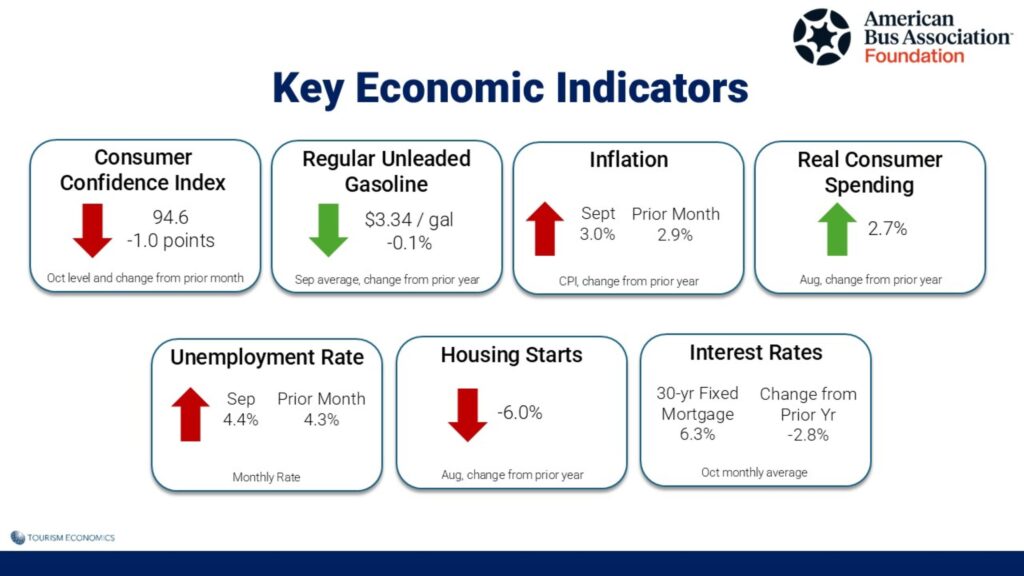Monthly Economy & Travel Industry Summary: November 2025
The recent shutdown has some impact while air travel briefly rebounds

At a Glance: Affordability the New Buzzword
- The 44-day government shutdown left a small but measurable impact on economic growth.
- The divide over the extension of the Affordable Care Act subsidies thrust affordability into the spotlight.
- A directional shift of future tariff adjustments may be emerging.

The Details
Although not a macroeconomic game changer, the longest government shutdown in US history did have a material impact on the pace of GDP growth.
The drag on GDP this quarter is estimated at 0.8 percentage points (ppts), but furloughed workers will receive retroactive pay, boosting GDP in Q1 2026 by 0.8 ppts. On an annual basis, we’ve lowered our 2025 GDP growth forecast for the US by 0.1 ppt to 2% and raised our projection for 2026 by 0.1 ppt to 2.4% to reflect the impact of the government shutdown and the timing of the payback.
However, government funding is not out of the woods. The government will plunge into another shutdown if lawmakers don’t act by January 30. The risks to the economy from a second shutdown are lower, though. First, it would occur on the other side of the holidays when retail spending is not as seasonally strong as it is in November. Second, the US Department of Agriculture was one of the few agencies that received full-year funding in the bipartisan deal to resolve the 43-day funding impasse. Therefore, SNAP benefits, which it administers, would be unaffected by another lapse in government funding.
While we anticipate lawmakers will likely be loath to play budgetary chicken with the midterm elections fast approaching, we can’t fully rule out another shutdown given how elevated partisan conflict has become during the past 15 years.
The expiring enhancements to the Affordable Care Act subsidies were at the heart of the shutdown, and ‘affordability’ became a buzzword in Washington DC following the resolution of the shutdown.
Groceries, healthcare, and shelter costs all experienced bouts of strong inflation after the onset of the Covid-19 pandemic, and surveys of consumer sentiment and confidence indicate consumers are still upset by the elevated costs of these essentials.
While the issue of healthcare subsidies still lingers, the Trump administration pivoted to other affordability concerns. The White House is reportedly working on introducing a 50-year mortgage to improve housing affordability. Such a loan would allow more prospective homebuyers to qualify for a residential real estate loan and reduce their monthly payments, but it would result in higher interest paid over the entirety of the loan and slow the pace of equity households would accumulate.
There are policy levers that the federal government can pull to boost the supply of affordable housing, such as the Low-Income Housing Tax Credit and the New Markets Tax Credit. Even so, to effectively tackle the issue of housing affordability, it will require coordinated action with state and local governments to reform zoning and land-use rules, and accommodate more types of housing.
Additionally, the administration turned to the issue of grocery affordability. Grocery prices are prominent in consumers’ inflation psychology, and consumer sentiment is highly sensitive to swings in food inflation, especially for lower-income households that allocate a disproportionate share of their disposable incomes to food.
On November 14, the White House issued an executive order exempting more than 200 agricultural products from the reciprocal tariffs the administration had previously imposed on trading partners. The order rolled back higher duties on foods such as beef, coffee, and bananas, which were previously subject to a range of reciprocal tariff rates of 10%-50%, depending on the country.
Although impactful for the exempted goods, we estimate the agricultural exemptions will have a negligible impact on the pace of overall inflation. Imports account for not quite 10% of the total value of consumer spending on food and non-alcoholic beverages for consumption at home. Plus, agricultural imports from Mexico – one of the largest food exporters to the US – have faced limited tariff increases due to high rates of compliance with the US-Mexico-Canada Agreement.
What matters more for the outlook, though, is the signal that this move sends about the directional shift of future tariff adjustments. As we near next year’s midterm election, the administration may broaden these tariff exemptions to a wider swathe of food products.
Already, the recently announced trade deal with Switzerland will lower their reciprocal tariff rate to 15% from 39%; and other trade agreements to lower tariffs on Brazil and India may also be in the offing.
At a Glance: Air Travel Rebounded in October
- TSA checkpoint volume in October grew at the fastest pace of the year.
- However, air travel in November was impacted by flight reductions due to the government shutdown.
- The World Cup is forecast to provide a significant lift to international travel in 2026.

The Details
Air travel in October, measured by the number of people passing through TSA security checkpoints in US airports, was 4% above the same month last year, the largest year-over-year increase since December 2024.
The notable growth in October extended a rebound in air travel that began in mid-summer. Checkpoint volume in the first half of this year fell nearly 1% versus the same period last year, but it was nearly 2% higher than prior year levels in the four months from July through October.
However, the positive momentum ran into a speed bump when, on November 7, 2025, the FAA directed airlines to reduce flights at 40 major U.S. airports due to staffing shortages during the government shutdown. These temporary reductions were designed to alleviate pressure on the air traffic system while controllers worked without pay. The rule was lifted on November 17, 2025, allowing normal operations to resume, but not before having a notable impact on air travel.
For the 7 days ending November 17, the day flight restrictions were lifted, TSA checkpoint volume was 5% below the same period last year. Conversely, checkpoint volume was 4% higher than the prior year comparison for the 7 days through November 6, the day before flight restrictions took effect.
Hotel occupancy rates did not benefit from October’s growth in TSA volume. Hotel occupancy was 2.4% lower than in October of last year, marking the eighth consecutive month that US hotel occupancy trailed prior-year levels.
The decline in international arrivals to the US is one factor impacting hotel occupancy rates. However, optimism is growing that next summer’s FIFA World Cup tournament will accelerate a rebound in international visitors to the US. After a 6.3% decline in international overnight arrivals to the US this year, international arrivals are forecast to rise 3.7% next year, with almost one-third of next year’s growth attributable to the World Cup (1.1 percentage point impact).
The 2026 edition of the tournament, held every 4 years, will kick off in the US on June 12 in Los Angeles, with the final game played in New Jersey/New York on July 19. Next year’s tournament features an expanded field of 48 national teams, the largest World Cup field ever, and consists of 78 matches across 11 US cities plus 26 matches in Mexico and Canada.
The US matches are scheduled to take place in major stadiums typically used for NFL games, with an average capacity of 75,000. Attendance at matches in the US is projected at 5.29 million, assuming 90% of available stadium capacity is filled.
We estimate the World Cup will attract 1.24 million international visitors to the US in 2026, of which 742,000 (60%) will represent an incremental boost over normal travel patterns. The remaining 40% will offset trips that are displaced due to the World Cup. Examples of displaced trips include travelers who shift travel plans due to higher prices, reduced flight or hotel availability, or to avoid the anticipated crowds in host cities during the event.
Hotels in host cities will likely see a significant lift in revenue during the tournament. We expect the tournament to generate incremental hotel room revenue across US markets approaching $900 million—comparable to 10 Super Bowls within six weeks.
Hosting the World Cup provides global exposure for the host nations and cities. Fans will take home first-hand experiences in the US and perhaps return for repeat visits, while others will gain awareness and familiarity with the host destinations through key channels, including media and broadcast coverage, dedicated marketing, and fan commentary. This type of exposure can contribute to future US visitation, beyond the specific event-related visits realized next summer. Amidst the optimism, lingering negative sentiment over the administration’s international trade policies represents a potential headwind, as do the costs, timing, and complexities of obtaining a visa. However, demand for events like the World Cup can be relatively inelastic, as these events represent a major demonstration of national pride and a ‘must-see’ experience for fans, effectively cutting through other concerns or hesitations. Even some enthusiasts from countries without participating teams will seek to be part of the significant event.
The Monthly Economy & Travel Industry Summary partners with Tourism Economics, an Oxford Economics company. Combining rigorous economic analysis with decades of travel industry expertise, Tourism Economics is an industry-leading insight resource. Learn more at www.tourismeconomics.com.

